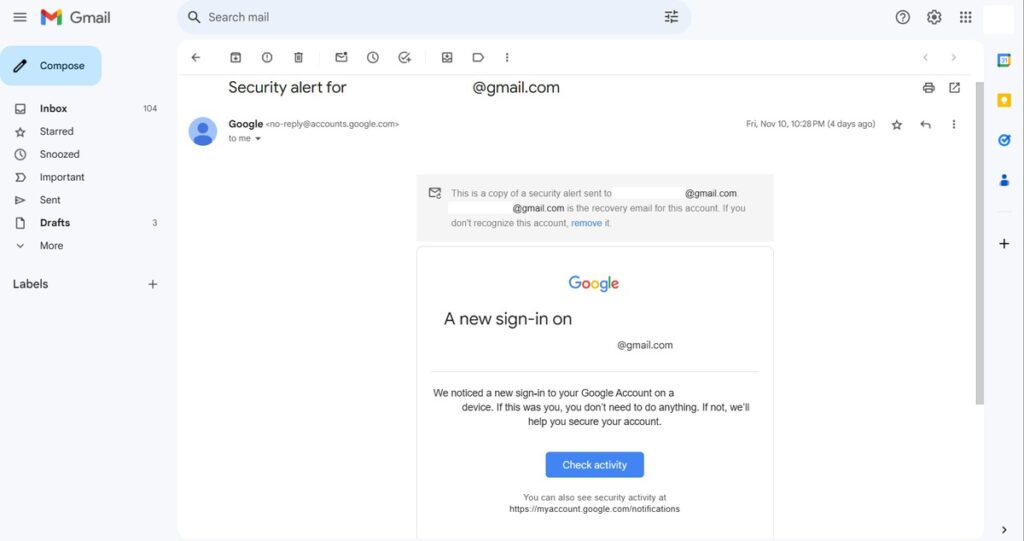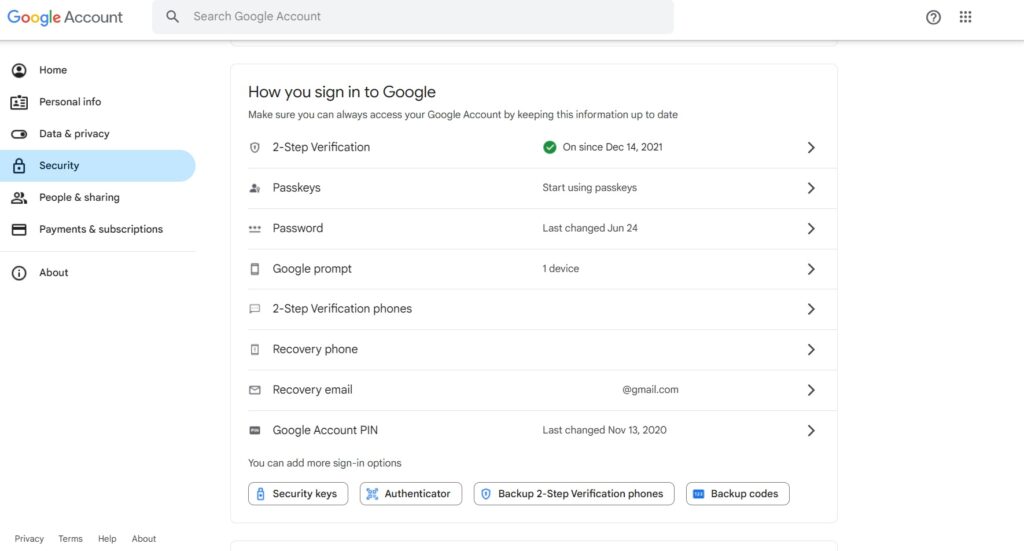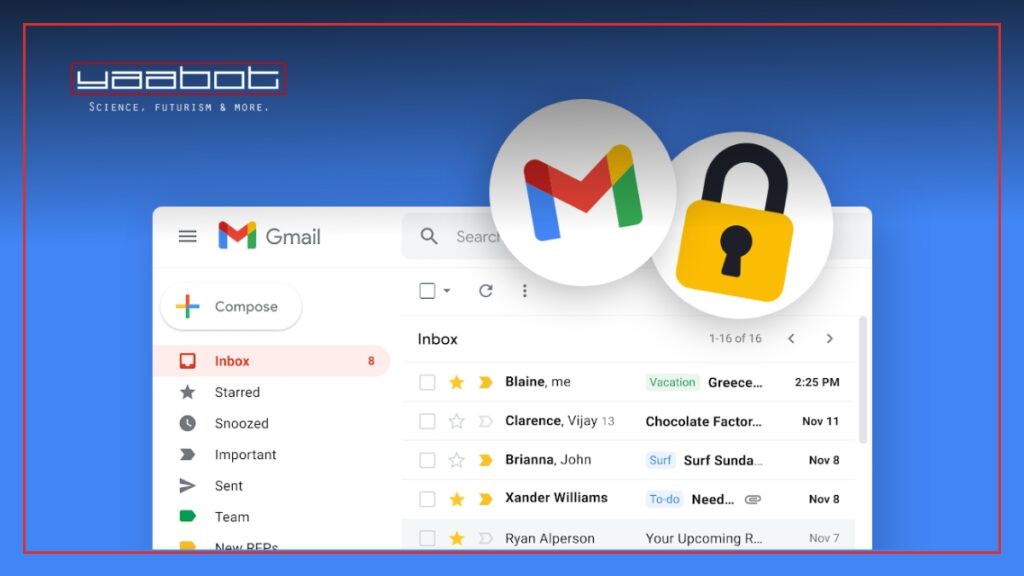Email has become an integral part of our personal and professional communications, changing how we connect and share information. But, very few people prioritize email safety, making themselves vulnerable to rising cyber-attacks. Did you know that over 75% of targeted cyberattacks start with an email? Clearly it’s vital to secure your email account to prevent your data from being leaked and used for nefarious purposes.
Gmail seems to understand the importance of safeguarding user accounts. There are more than 1.8 billion active users on Gmail – clearly a popular choice for personal and business use. And its user base has been growing steadily over the years.
Gmail security alerts inform users about potential security issues like unauthorized access attempts, phishing attacks, and suspicious activities. Key features include Two-Factor Authentication (2FA), HTTPS connections, account recovery options, and advanced authentication methods to secure accounts effectively.
One of the standout features in Gmail’s security arsenal is the robust Gmail security alerts system. This easy guide will explore everything you need to know about Gmail security alerts. You’ll learn how to secure your Gmail account and also understand the alerts’ functionality.
Understanding Gmail Security Alerts

Gmail security alerts are designed to alert you to potential security threats and unauthorized access attempts. These alerts act as a proactive defense mechanism, helping you stay one step ahead of cyber threats.
Powered by advanced algorithms and machine learning, Gmail security alerts scrutinize many factors, including login patterns, device information, and geographic locations. The system establishes a baseline of your typical usage behavior, and any deviations from this norm trigger an immediate alert.
Here’s more on how Gmail critical security alerts protect your emails:
- Gmail security alerts are able to detect threats in real-time. Whether it’s an unfamiliar device attempting to access your account or a sudden surge in login attempts, these alerts work swiftly to notify you of potential risks. Real-time threat detection is instrumental in preventing unauthorized access and mitigating potential damage to your account.
- Gmail provides customization options for security alerts. You can tailor your alert preferences to align with your comfort levels, striking a balance between staying informed and avoiding unnecessary alert fatigue.
- Beyond the immediate functionality of Gmail security alerts, Gmail actively engages in educational outreach programmes to empower users with the knowledge to recognize and thwart potential threats.
Gmail Security Alert Types
There are two types of Gmail security alerts:
- Standard security alerts
Here’s how Gmail standard security alert works:
- Unusual login activity
Standard security alerts are often initiated by unusual login activity. If your account is accessed from a location or device not typically associated with your usage patterns, Gmail flags this as a potential security concern. These alerts prompt users to review their recent login history. - Multiple login attempts
A sudden influx of login attempts within a short time frame can trigger a standard security alert. This may indicate a brute-force attack or an automated attempt to gain unauthorized access into your account. This prompts users to verify the legitimacy of the login attempts and take appropriate action, such as changing passwords or enabling additional security measures.
- Device changes
Gmail issues a standard security alert if your account is accessed from a new or unrecognized device. Users can review and verify the legitimacy of the new device, preventing potential unauthorized access.
- Critical security alerts
Here’s how Gmail critical security alert works:
- Potential account takeover
Critical security alerts are raised when there is a substantial risk of an account takeover. This could result from suspicious login activity, unauthorized access attempts, or other factors indicating a severe security threat. The urgency of critical security alerts demands immediate action. Users are notified of the potential compromise, guiding them through steps to secure Gmail accounts and prevent unauthorized access.
- Unusual account activity
Critical security alerts may be triggered by unusual account activity that suggests a higher risk of compromise. This could include changes to critical account settings, such as password resets or recovery email modifications. These alerts prompt users to review recent account activity, ensuring that any unauthorized changes are swiftly addressed to prevent security issues.
Differentiating Factors
Gmail security alerts are differentiated on the basis of urgency and severity of threat.
- Urgency and actionability
Here’s how it differs for both alerts:
- Gmail standard alerts: Standard security alerts typically signify potential risks that require user attention but may not require immediate action. While they require user attention, standard alerts often allow for a more measured response. Users are encouraged to investigate the flagged activity, ensuring that any potential security concerns are addressed promptly but without the urgency associated with critical alerts.
- Gmail critical security alert: These alerts are characterized by their urgency, indicating a higher level of threat that necessitates immediate response to secure the Gmail account. The critical nature of these alerts necessitates users to take immediate steps to secure their accounts. This could involve changing passwords, enabling Two-Factor Authentication (2FA), or verifying account settings to prevent further compromise.
- Severity of threat
Here’s how it differs for both alerts:
- Gmail standard alert: Standard security alert addresses issues related to unusual but not high-risk activity. They act as cautionary signals, providing users with a heads-up on potential security concerns. These alerts create awareness and encourage users to investigate further, ensuring any anomalies are addressed and potential risks mitigated before they escalate.
- Gmail critical security alert: Gmail critical security alert, on the other hand, is reserved for situations where the threat level is significantly higher. They are triggered by events that indicate a substantial risk of an account takeover or other severe security breaches. Whether it’s detecting a sudden surge in unauthorized login attempts or identifying changes to critical account settings, critical alerts prompt users to take immediate and decisive action.
Gmail Security Features
Gmail security features are designed to provide a comprehensive defense against potential threats. Discover how features like Two-Factor Authentication, account recovery options, and suspicious activity detection contribute to your Gmail’s impervious security.
Two-Factor Authentication (2FA)
Two-Factor Authentication (2FA) is the bedrock of Gmail security alert infrastructure. It adds an extra layer of protection beyond the traditional username and password combination. With 2FA enabled, accessing your Gmail account requires not only something you know (your password) but also something you have (a unique code sent to your mobile device).
Users can easily enable 2FA in their Gmail account settings. Once activated, they receive authentication codes via SMS, adding a barrier against potential account compromise.
Suspicious Activity Detection
Gmail’s advanced algorithms continuously monitor account activity for signs of suspicious behavior. This includes recognizing unusual login patterns, unfamiliar devices, or unexpected changes to account settings. This feature acts as a preemptive strike against potential threats. If any irregularities are detected, Gmail promptly triggers security alerts, notifying users of the suspicious activity and empowering them to take immediate action.
Secure Connection (HTTPS)
Gmail encrypts data in transit. The use of Hypertext Transfer Protocol Secure (HTTPS) encrypts the connection between your device and Gmail’s servers, preventing eavesdropping and unauthorized access during data transmission. Gmail automatically uses HTTPS, providing users with a secure environment without the need for manual configuration.
Account Recovery Options
Gmail enables users to recover their account if they are facing challenges accessing their accounts. These options include alternative email addresses and phone numbers linked to the account.
Gmail encourages users to keep recovery information up to date, minimizing the risk of unauthorized access or the potential for account lockout.
Phishing and Malware Protection
Gmail employs advanced algorithms and machine learning to identify and filter out emails with malicious attachments. It warns users about potential threats and prevents harmful content from reaching their inboxes. Gmail’s security systems are regularly updated to adapt to new phishing tactics and emerging malware threats, ensuring a constantly evolving defense mechanism.
Starting in 2024, Gmail will require bulk senders (who send over 5000 messages to Gmail addresses daily) to authenticate their email, allow an easy unsubscribe option, and stay under a reported spam threshold.
Advanced Authentication Methods
Gmail supports advanced authentication methods, including Security Keys and Google Authenticator.
Security keys act as a second form of authentication, enhancing security by requiring the physical presence of the key for access. For users seeking an additional layer of security beyond traditional 2FA methods, Security Keys provide a hardware-based solution, making it even more challenging for unauthorized entities to compromise accounts.
Google Authenticator is a free two-factor authentication (2FA) app developed by Google that adds an extra layer of security to online accounts, including Gmail. Generating time-based one-time passwords (TOTP) requires users to verify their identity during the login process, supplementing the conventional username and password. Google Authenticator enhances cybersecurity, and its usage is recommended across various online accounts to bolster protection against potential cyber threats.
Learn How to Secure Your Gmail Account
You are just a few steps away from securing your Gmail account and receiving timely security alerts. Follow these steps:
Step 1: Sign into your Gmail account.
Step 2: Tap/click on your Gmail profile picture on the top right-hand side. Under that, select the ‘Manage Your Google Account’ option.
Step 3: On the left-hand side panel, tap/click on the ‘Security’ option.
Step 4: Under Security, as discussed in this article, you can see several options like 2FA, Google Account pin, Security Keys, Backup codes and more to secure your Gmail account.

Step 5: Having a green shield means your Gmail account is secure. Under Security, you can also see several options like Your Saved Devices (includes mobile, desktop, and TV) and Third-party apps & services (You can review the amount of data shared with third-party apps and services when you log in with your Gmail account and can reject permissions accordingly.)
Under the Security option, Google also provides an option to check whether your email address is on the dark web and take the necessary steps. Another essential feature under security is that you can find your lost phone with the help of your Google account.
Step 6: Enable these backup options according to your preference. Make sure to pay attention to Gmail security alerts.
Gmail Security in Action
Gmail security alerts serve as the frontline defenders of your digital identity. By understanding their nuances, mastering Gmail’s security features, and adopting best practices, you empower yourself to navigate the online landscape securely. Stay informed, stay secure, and let Gmail Security Alerts be your vigilant guardians in the realm of digital security.
For more technology-related news, subscribe to Yaabot!


